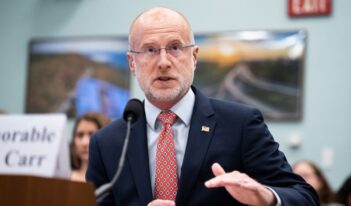
The FCC ought to consider new approaches to setting rates for captioned telephone service providers.
Under the leadership of current Chairman Ajit Pai, the Federal Communications Commission (FCC) has made substantial progress in eliminating unnecessary costly regulations and modernizing legacy regulatory programs. But there is an important FCC program—the provision of Internet Protocol Captioned Telephone Service (IP CTS)—still in need of meaningful reform. Unlike some other high-profile FCC regulatory activities, the IP CTS program tends to run under the radar. But it is time for the Commission to adopt reforms to refashion the captioned telephone service program in a market-oriented way.
IP CTS is a form of telecommunications relay service (TRS) that allows individuals with a hearing impairment to both read captions and use their residual hearing to understand a telephone conversation. The availability of IP CTS to hearing-impaired persons fulfills an important societal function. Indeed, the Communications Act requires the FCC to ensure that relay services for hearing impaired persons, like IP CTS, are functionally equivalent to voice communications services used by persons without disabilities.
Importantly, the Communications Act also requires the FCC to ensure that telecommunications relay services, including IP CTS, are made available “in the most efficient manner.” This direction is an acknowledgement by Congress that, absent a focus on efficiency, the provision of IP CTS, which is supported by surcharges added to consumers’ telephone bills, likely would not be sustainable over time.
In recent years, demand for captioned telephone services has increased substantially, in part because of the aging of the American population and the hearing impairments associated with aging. From 2011 to 2017, the annual IP CTS minutes of service grew exponentially from approximately 29 million to 363 million. The FCC projects the compensation paid to the competing IP CTS providers handling those minutes of service during the 2018-2019 period to be almost $900 million. At the same time that IP CTS usage has continued to grow rapidly, the TRS contribution base that supports the payments to IP CTS providers has shrunk. This is because consumers are migrating away from the traditional telephone services subject to the TRS surcharges. Thus, the FCC has warned that this scenario “poses an ever-increasing threat to the sustainability of IP CTS and all forms of TRS.”
In June 2018, the FCC took a step to try to control the escalating costs of the IP CTS program. Historically, the compensation rate paid to the competing IP CTS providers has been derived by relying on cost data the providers submitted in support of their claimed expenses in making the service available. In other words, the rate generally was established by employing traditional “cost-plus” ratemaking based on allowable expenses plus a return on capital. In its June 2018 order, the FCC determined the existing compensation rate of $1.95 per minute exceeded the reasonable cost of providing service. So, on an interim basis, it reduced the compensation rate to $1.75 per minute from July 1, 2018 to June 30, 2019, and then to $1.53 per minute from July 1, 2019 – June 30, 2020. It declared that it adopted these interim IP CTS rates to bring the per minute compensation “more in line with the reasonable costs of providing this service.”
Most importantly, the agency has sought public comment on alternatives to traditional “cost-plus” ratemaking. To reform the IP CTS program so that the compensation rate, to the extent possible, reflects the actual costs of providing service and replicates the rate that would prevail in a free market, the Commission should implement a uniform compensation rate which is applicable to all IP CTS providers.
In its further notice, the Commission references suggestions by some service providers that it should adopt a tier-based rate structure that compensates service providers differentially based on their size, emergent status, or the technology used to provide the service. But a single uniform rate creates incentives for all service providers to offer high-quality services at a reasonable cost. A tiered rate structure reduces the incentives for high-cost providers to find ways to innovate and be more efficient. This is true whether the service provider is smaller than average or has more recently entered the market.
Going forward, the uniform compensation rate should be derived by implementing either a price cap or, better yet, a reverse auction regime. Each of these approaches is superior to the current one that is dependent on the submitted costs claimed by the IP CTS providers.
Under a price cap regime, once an initial, presumably cost-based rate is set, service providers may not increase their rates above the cap to recover any claimed increases in costs. By the same token, if providers are able to lower their costs, they retain the resulting profits. In contrast to a ratemaking regime based on reported costs, a properly formulated price cap regime, aside from avoiding the need for the regulatory authority to make contentious determinations regarding allowable costs, creates incentives for the service providers to become more innovative and efficient. Thus, as the FCC recognized as far back as 1997, price caps encourage service providers “to reduce costs, invest efficiently in new plant and facilities, and develop and deploy innovative service offerings.”
In a separate statement issued in conjunction with the FCC’s recent call for comments, Commissioner Michael O’Rielly urged the agency to explore the use of a reverse auction to set the compensation rate. In a reverse auction, the lowest—not the highest—bidder or bidders are awarded what is on auction as sellers bid for the prices at which they are willing to sell their services or products. In the case of an IP CTS auction, the lowest bidder or bidders—depending on the auction design—would establish the rate at which IP CTS customers can be served during whatever period is designated by the auction rules. Thus, a reverse auction has the effect of allocating scarce TRS fund resources to the most efficient, lowest-cost provider or providers. The reverse auction encourages cost-effective operation consistent with the congressional directive that the IP CTS program be run as efficiently as possible.
Adoption of either a price cap or a reverse auction regime would be a significant step in modernizing the IP CTS program. All things considered, a reverse auction likely would yield a compensation rate that most closely replicates the rate obtained in the free market. This, in turn, is what is most likely to lead to long-term sustainability of the captioned telephone service program.




